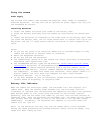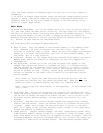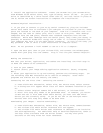
Using the camera
Power Supply
The ViviCam 2750 camera uses standard AA Alkaline, NiCD, NiMH, or renewable
alkaline batteries. You may also use an optional AC power supply that lets you
use household AC current.
Installing Batteries
1. Invert the camera and place your thumb on the battery door.
2. Slide the battery door away from the camera as indicated by the directional
arrow.
3. Insert the batteries as indicated on the inner side of the battery door. When
you close the battery door, the “+” signs should fall in contact with top of the
batteries, and the “-” signs should contact the bottom of their respective AA
cells.
Notes:
• If you are not going to be using the camera for an extended length of time,
remove the batteries to prevent leaks or corrosion.
• Never use manganese batteries.
• Do not mix old and new batteries.
• Low temperatures (below 32 F) may reduce the output efficiency of batteries,
shortening their operational life.
• The recommended battery types are AA Alkaline, Nickel-Metal Hydride (NiMH)
rechargeable batteries, or rechargeable/renewable alkaline.
• Note: When you remove alkaline batteries from a digital camera, do not
dispose of them hastily. Digital cameras deplete AA batteries quickly, but
not completely. Studies have shown that batteries, which appear “dead” to a
digital camera, are still more than adequate for most other consumer
electronic devices. Try it and see!
• If you must dispose of your old batteries, please exercise environmentally
correct means of disposing, or recycling them.
Battery Life Indicator
When the camera has sufficient power, the Low-Power icon (LCD display) will
remain dark. When the battery power becomes low, the Low Power icon will
illuminate to indicate that the batteries are depleting and need to be replaced.
When battery power is low, avoid using the Flash (or Auto-Flash) feature.
Generally, once the Low Power icon comes on, you will have ten more minutes of
operation time. When the batteries are extremely low, the image LCD will appear
only briefly when you attempt to turn it on, and then it will go dark almost
immediately. Ultimately, the batteries will deplete to the point where the
camera will not turn on.
Note: If the batteries are very low, and the camera does a total shutdown
during the image processing and storage function (while saving am image), that
image will most likely be lost.


















